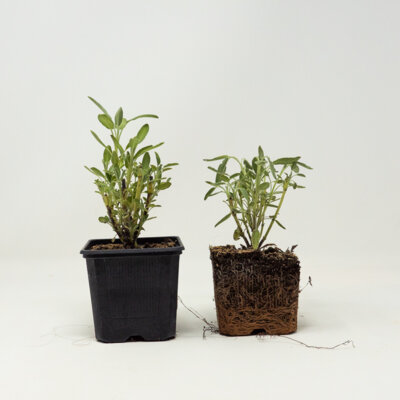
3 Plants of Sage AB - Salvia officinalis
Sage officinale forms a bushy, highly branched shrub with woody stems at the base, 30 to 80 cm high. Its oblong, grayish-green leaves are powerfully aromatic, and its long flower stalks are adorned with blue-purple flowers 2 to 3 cm long.
Sage plants are perennial and can be grown outdoors, in pots or containers.
How to grow sage?
Like all types of sage, flowering sage thrives in fertile, light, well-drained soil and in sunny conditions.
Transplant sage plants in early autumn or spring, after the last frosts, 30 to 40 cm apart in all directions.
Apart from watering in hot weather, this hardy aromatic requires little maintenance.
Cut back the plants at the end of the season for better growth the following spring. Be careful not to cut too much into the wood, however, as this could irreversibly weaken the sage plants. Prune the upper part, at least 15 cm from the base of the plant, and mulch to protect them from the winter cold.
For more information, consult our guide to transplanting plants.
When and how to harvest sage?
Sage can be harvested all year round, as and when required. However, its leaves are best picked just before flowering, in the morning, before the hottest hours, when the plant has evacuated as much moisture as possible from the night but has not evaporated its essential oils. Traditionally, sage is one of the plants harvested at dawn on St. John's Day, June 24.
Cut off the upper two-thirds of the stems with scissors or pruning shears.
How to store sage?
Sage leaves retain their full aroma even after drying.
- Gather the stems into bunches.
- Hang the bunches in a well-ventilated place away from light until completely dry.
- Collect the dry leaves.
- Store in an airtight jar.
What companion plants should I choose for my Sage plants?
Sage plants are good companions for carrots, protecting them from carrot fly. They also protect cabbages, and other species in this botanical family, from cabbageworm.
Cucumbers generally dislike aromatic herbs, and sage in particular.
Sage: aromatic and medicinal, a symbol of strength and health.
Sage officinale, the sacred plant of family herbalism and cooking, has countless virtues. It is renowned for its tonic and stimulating properties, as well as its antiperspirant, antiseptic, digestive and antispasmodic properties.
Sage is generally taken as an infusion of fresh or dried leaves. Be sure to take breaks during cures: consuming plants for long periods or in excessively large quantities is never recommended.
In cooking, sage is a wonderful flavoring for meat, fish and vegetables. It is also used to make wines and liqueurs.
Shipping and delivery
- Orders are dispatched every Monday.
- Shipment to mainland France only.
- Shipping cartons designed for optimal plant protection.
- Free shipping does not apply to plants.






